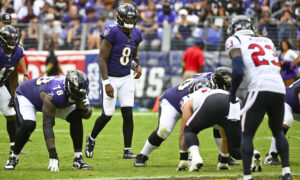OWINGS MILLS — Ravens tight end Mark Andrews helped a woman in medical distress on a flight from Baltimore to Phoenix on Thursday.
The woman, traveling on Southwest, had a mid-flight medical emergency, according to another passenger. A doctor and nurse who came to her aid found a weak pulse, low blood pressure, and used oxygen to help her breathe, according to eyewitness Andew Springs, who was on the flight and shared the episode on X, formerly Twitter.
Springs said Andrews, who was in an aisle seat, stood and said, “Could it be her blood sugar? I have a diabetic testing kit.”
Andrews, who was 9 years old when he was diagnosed with type 1 diabetes. then told the doctor and nurse how to use his diabetic test kit. They were able to stabilize the patient’s heart rate, and she was met by paramedics as soon as the flight landed, Springs said.
“Watching complete strangers spring into action to help save someone’s life is truly amazing,” wrote Springs, who described the ordeal as “genuinely scary.”
The Ravens confirmed the incident, and Andrews released a statement that it was him on the plane. He deflected credit.
“In addition to the fast-acting flight attendants, the real heroes are the nurse and doctor who also happened to be on the plane,” Andrews said in a statement. “Thankfully, they were able to provide the woman the quick assistance she needed.”
Dr. Marc Kai, a primary care physician with Mercy Family Care Physicians in Baltimore, said it was vital for Andrews to recognize her signs of distress. The fact that they were on a plane and had limited resources added to the challenge of providing medical assistance.
“It’s wonderful he popped up. It’s not always helpful to have a bunch of people offering suggestions, but in that type of scenario, it’s perfect because we’re limited in what we can do on a plane,” Kai said. “Having the ability to test blood sugar is great. As physicians, we are trained to know there are a whole bunch of reasons someone could be in distress, especially if they are confused or unconscious.
“If we are in a hospital these are easy to address and fixable if someone’s sugar is running low, if they’re running low on oxygen, their breathing is difficult. On a plane, we don’t have that. We have the blood pressure, and we can try to find a pulse to see if they’re breathing. It was very helpful that he was able to show them how to use the kit.”
Vanessa V. Redd, chief of emergency medicine at the University of Maryland St. Joseph Medical Center in Towson, said in-flight emergencies are not uncommon and although all airlines carry emergency medical kits and AEDs [automated external defibrillators], the contents are variable and can be sparse. Bystanders on a flight can often provide equipment or medications that could be lifesaving, like a glucometer, EpiPen, or naloxone. Hypoglycemia is a dangerous cause of unresponsiveness that can be quickly corrected once identified.
“If the airline’s emergency medical kit does not contain a glucometer, a quick-thinking passenger who provides one can be a lifesaver,” she said.





















